😅
Email marketing is a powerful tool that businesses can use to build stronger relationships with their customers and drive sales. It is the most profitable and cost-effective direct marketing channel, generating an average return on investment of $36 for every $1 spent. As of 2022, 68% of businesses reported using email to send content to their contacts.
For this reason alone, email should be a key pillar of your digital marketing strategy. Not doing any email marketing is like leaving money lying out on the table.
This guide will explain what email marketing is, how it works, and how to get started. By the end, you’ll have a solid grasp of the basics along with the know-how to launch an effective email marketing strategy for your business.
What is email marketing?
Nothing makes a list grow faster than premium content.
Guarded content like ebooks, reports, checklists, or infographics are great ways to grow your contact list. Visitors get valuable content in exchange for joining your newsletter list. It’s a win-win!
Special offers and discounts are a great way to get people onto your list, too. For example, clothing brand Mango offers 10% off your first order when you subscribe to their newsletter.

How to write a marketing email
Now that you’ve started building your contact list, the next steps are defining an email marketing strategy and creating the content!
1. Define an email marketing strategy
To define your email marketing strategy, think about what you want to achieve with your first campaign. Here are some common goals for email marketing beginners:
- Promoting a new product
- Sharing a discount with loyal customers
- Getting more downloads for your latest ebook
- Updating subscribers with company news
Your goals can be specific or broad — as long as they fit with your business and your audience. In either case, having a clear, measurable goal will make it easier to create your email content.
2. Design your marketing email
Email design doesn’t have to be difficult or overly technical. Using a drag-and-drop editor, you can easily create stunning and professional marketing campaigns.
There’s no need to get hung up on creating fancy, elaborate emails. More importantly, you should focus on creating an email that embodies your brand, whatever it may look like. Oftentimes, this means keeping it simple. You can always build upon this later on as your skills grow.
Just follow email design practices to make your campaigns as impactful as possible.
A few tips for making a strong email design are:
- Keep text to the point
- Use images and on-brand visuals
- Leave breathing room for the eyes
- Include a clear CTA
- Use your company logo and branding
- Use responsive templates to optimize for mobile
Save time with pre-made email templates
For beginners and seasoned pros alike, email marketing templates are the perfect shortcut to standout email design.
Just pick one you like. Customize it to match your brand colors and font. Then reuse it for future email newsletters. All you’ll have to do is update the content. Quick and easy!
Brevo has over 40 newsletter templates available on all plans (even the free one). There are also plenty of free email templates available from other sources.
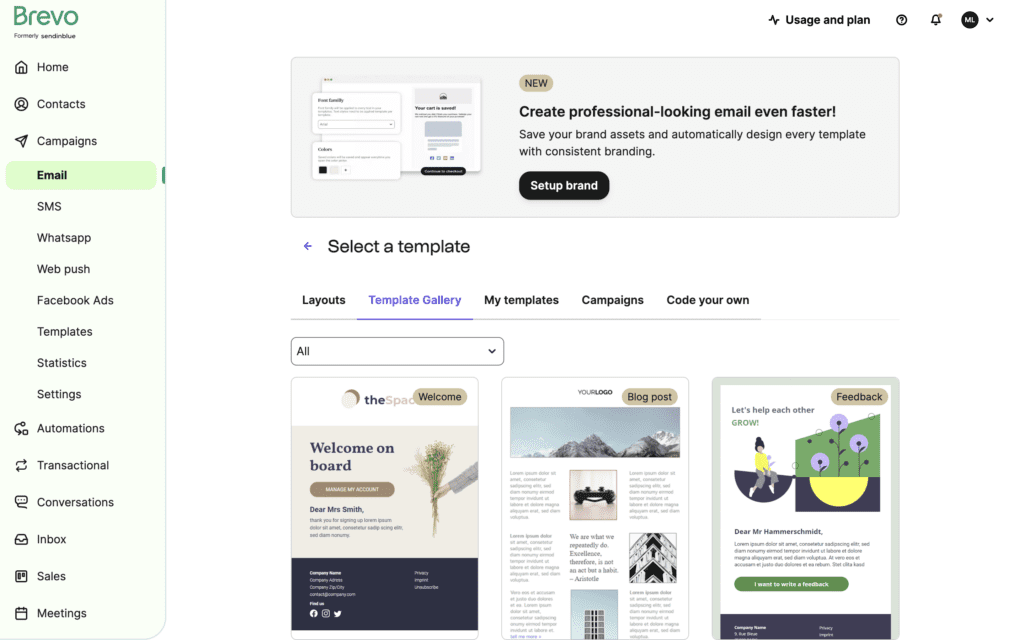
Email marketing templates
Brevo offers 100% responsive email templates, meaning they automatically adjust their formatting to fit the device they’re viewed on — mobile, tablet, or desktop.
3. Optimize your email subject line, sender name, and preview text
Email subject line

Introducing one of the most important elements of your email marketing campaign: the email subject line.
These few words could determine whether your email is read or not. And with so much competition in the inbox these days, they need to stand out.
Aim to create intrigue or a desire to open in just a few words.
- Keep the subject line to 50 characters.
- Highlight your most interesting offer.
- Appeal to your subscribers’ emotions and ambitions.
- Use your brand voice
- A/B test your subject lines
- Avoid over-promotional words
- Don’t use all caps
- Don’t use excessive punctuation
- Do use one or two emojis if it fits your brand
AI is a useful tool for developing subject lines. AI technology is trained to find what works and can help you learn how to do it well. An email tool with AI capabilities like Brevo makes subject line creation easy.
Further reading: 150 Email Subject Lines: Examples, Best Practices, and More
Sender name
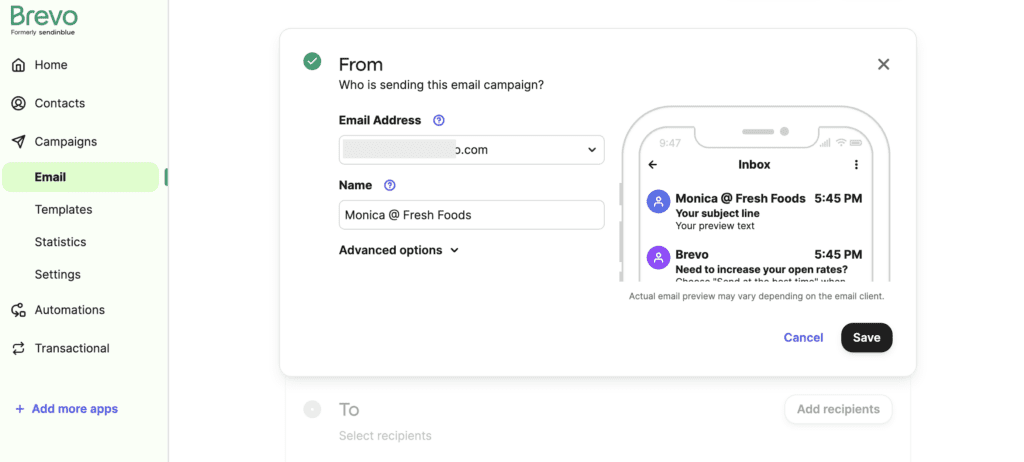
When you get an email, what’s the first thing you look at? Probably who it’s from.
The sender name answers the recipient’s first subconscious question: Is this genuine or is it spam?
The best way to reinforce trustworthiness and brand recognition is to incorporate your brand name into the sender name. There are several ways to go about this:
- Your company/brand/newsletter name on its own
- A combination of brand name and your first name (e.g. Dimira at Brevo)
- A distinct sender name to differentiate specific types of email content (e.g. Brevo Product News)
To be easily recognized in the inbox, use the same sender name and address for all campaigns.
Avoid no-reply email addresses, as these diminish trust in your brand and prevent subscribers from reaching out with questions.
Preheader/preview text
The email preheader (or preview text) is the snippet of text that appears after the email subject line for certain email clients, particularly on mobile devices. That is what you see in the blue box below.

The preheader adds valuable context to your subject line and can significantly boost your open rates. The subject line and preheader should work together to start telling the reader a story.
Again, it should instill enough curiosity to make the reader want to open the email and learn more.
Fail to set a preview text and the email client will see the first line of text. This isn’t always an issue, but it might mean a missed opportunity to grab subscribers’ attention.
4. Write your email copy
Email copy needs to offer value, feature topics that interest your audience, and embody your brand’s tone of voice.
To write persuasive, engaging email copy, keep these tips in mind:
- Ask yourself, “What does my audience need from me? How can I help?”
- Imagine you’re writing to one person.
- Show your brand personality.
- Tell a story.
- Write to instill curiosity, starting with the email subject line — more on that below.
- Use a conversational tone and write the way you speak.
- Break up the copy with short paragraphs and use bullet points where possible.
- Use the name of a real person for the email signature instead of a faceless brand logo.
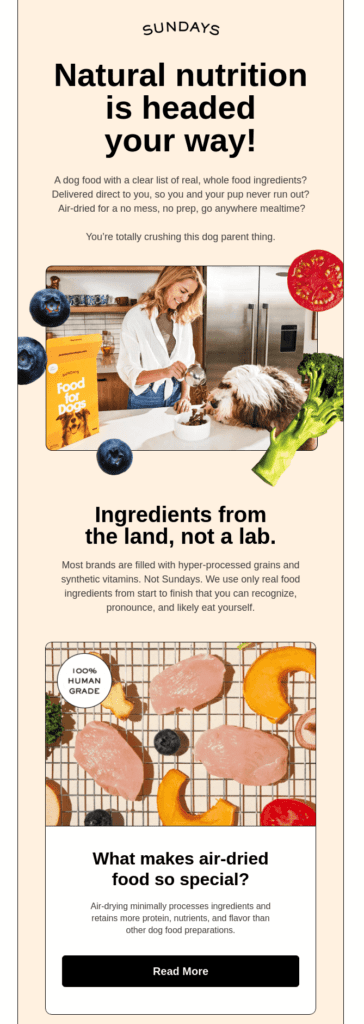
This email by Sundays has a clear tone of voice that matches the brand’s personality. The copy is concise and easy to understand.
When is the best time to send a marketing email?
Rather than choosing a random day and time to send your emails, be strategic. Think about what you know about your audience and choose the best time to send emails for them.
Brevo’s research showed that email marketing campaigns tend to perform better when sent on Tuesdays or Thursdays in the mornings around 10 AM or in the afternoons around 3 PM.
But, what works for most may not work best for you. It’s important to test different times to see where the sweet spot is for your audience. Or, use Brevo’s Send Time Optimization feature, which selects the best time for each individual contact based on previous engagement data.
11 Email marketing strategies for success
This next section focuses on strategies and email marketing best practices.
1. Never buy email lists
Building an email list can be slow, especially when you’re just starting out. Buying a list might seem like a tempting shortcut, but trust us — it’s a terrible idea.
Buying a list will put your business at risk because:
- Sending unsolicited emails and storing people’s data in your CRM without consent is illegal per the GDPR.
- People are more likely to mark unsolicited emails as spam, damaging your email sender reputation and potentially ending you up on an email blocklist.
- Most email marketing services will refuse to work with you because purchased lists can harm the deliverability of other users on shared IP addresses.
In short, don’t buy email lists. Build your list organically — however slowly — and you’ll reap the benefits in the long run.
2. Use double opt-in signup forms
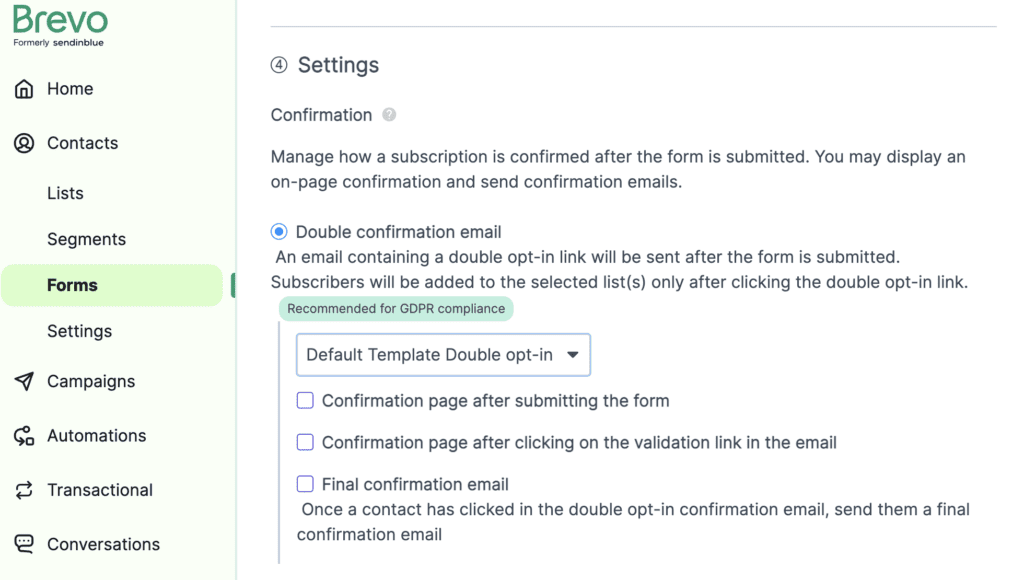
As already mentioned, the term “opt-in” refers to the signup process. There are two different types of opt-in for email marketing:
- Single opt-in is when the subscriber is added to the email list once the signup form is submitted.
- Double opt-in is when you send a confirmation email with a link to each new subscriber. The subscriber must click the link to complete the subscription. Without this verification, they won’t receive emails from you.
Sure, double opt-in adds an extra step between the potential subscriber and your list. But far from being an obstacle, this process is important — especially for email deliverability.
Double opt-in eliminates any misspelled email addresses that would otherwise generate a hard bounce. It also rules out spam traps and acts as proof of subscriber consent — a GDPR requirement.
For better email marketing, double opt-in is the way to go.
3. Segment your mailing list
As your email list expands, it’s likely to contain diverse buyer profiles.
List segmentation is the process of dividing your list of subscribers into smaller sub-lists with common traits. The idea behind this technique is to engage subscribers with more relevant, targeted emails.
Typically, contact lists are segmented by demographic information like age and location, as well as customer information like lead score and purchase history. (This is where having a contact CRM database that works with your email marketing tool comes in handy as it stores information like this about your contacts.)
To get a head start on segmentation, add subscribers to separate lists during signup by asking about their email content and frequency preferences.
Email marketing signup form example: Bloomingdale’s
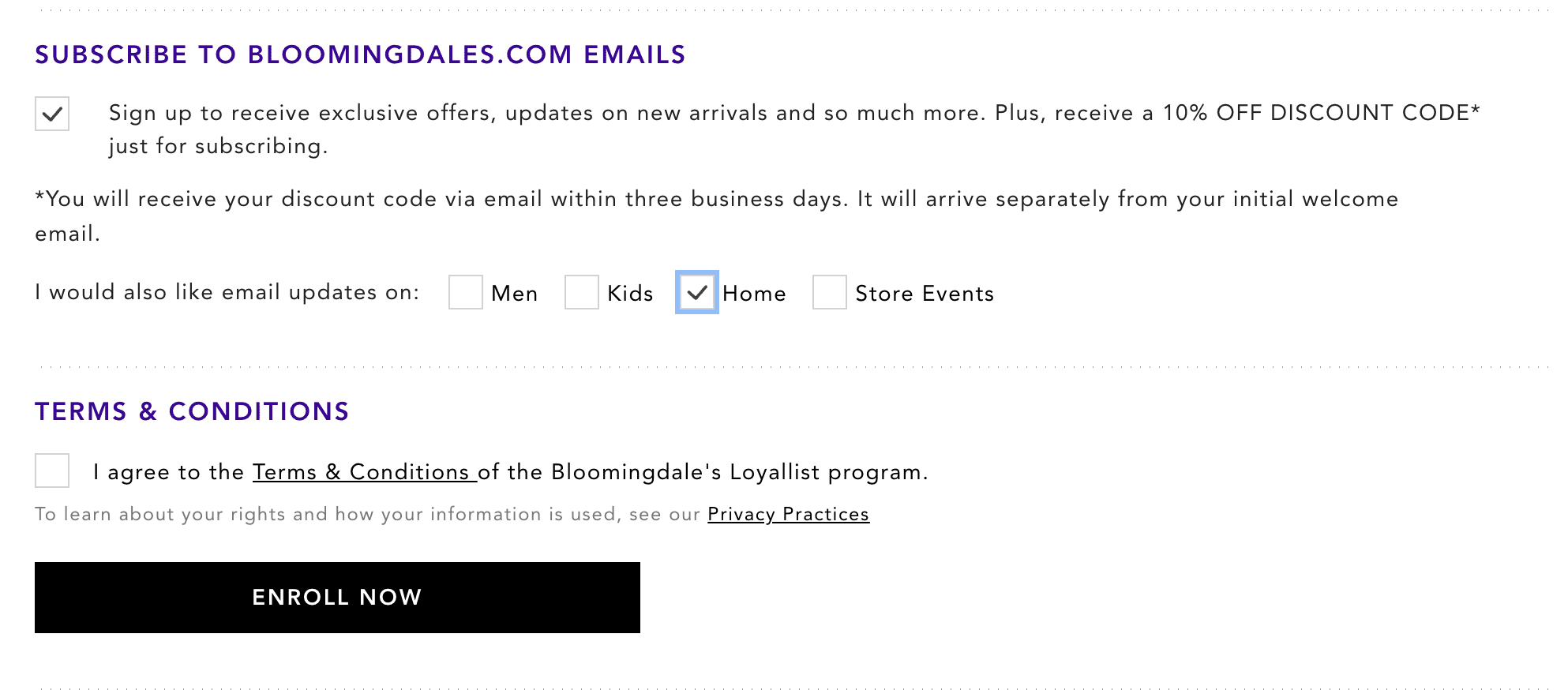
This signup form by Bloomingdale’s asks customers to choose the kind of content they’d like to get in their inboxes. Every person who signs up for “home” will be added to the “home” email list in a CRM.
From there Bloomingdale’s can easily create specialized campaigns for contacts in this segment and send them relevant content.
The more you know about your customers, the more relevant and valuable the content will be that you send them.
4. Personalize your marketing emails
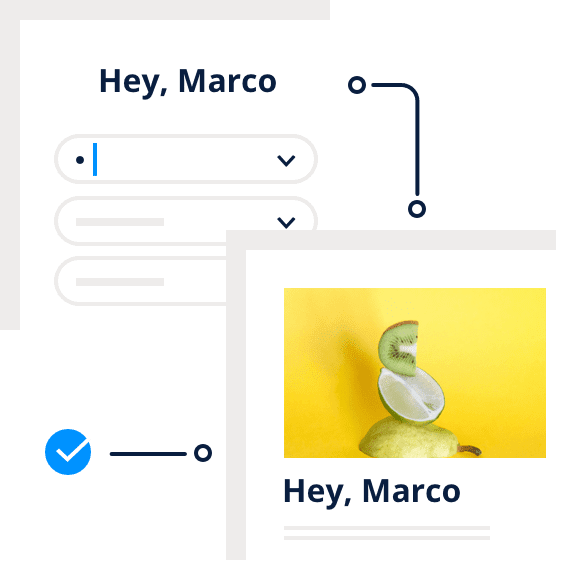
People generally appreciate when brands add personal touches and pay attention to small details. When it comes to making us feel valued and understood as a customer, a little personalization goes a long way.
This rings true for email marketing, too.
Email personalization is essential to building relationships with prospects and customers.
Here are some simple email personalization ideas to help increase your open, click-through, and conversion rates.
- Use subscribers’ first names in the email subject line and content.
- Consider time zones when scheduling campaigns to maximize the chances of your email being read. Where are the bulk of your subscribers located?
- Segment contacts so that messaging is targeted and relevant.
- Use behavior-triggered emails based on how customers interact with your product/service.
- Recognize users’ milestones with achievement emails
- Send tailored product recommendations
Recent data by McKinsey & Company shows the importance of personalization based on consumer insight. The bottom line — customers like personalization. It helps them see more of what they want and makes them feel understood by brands.
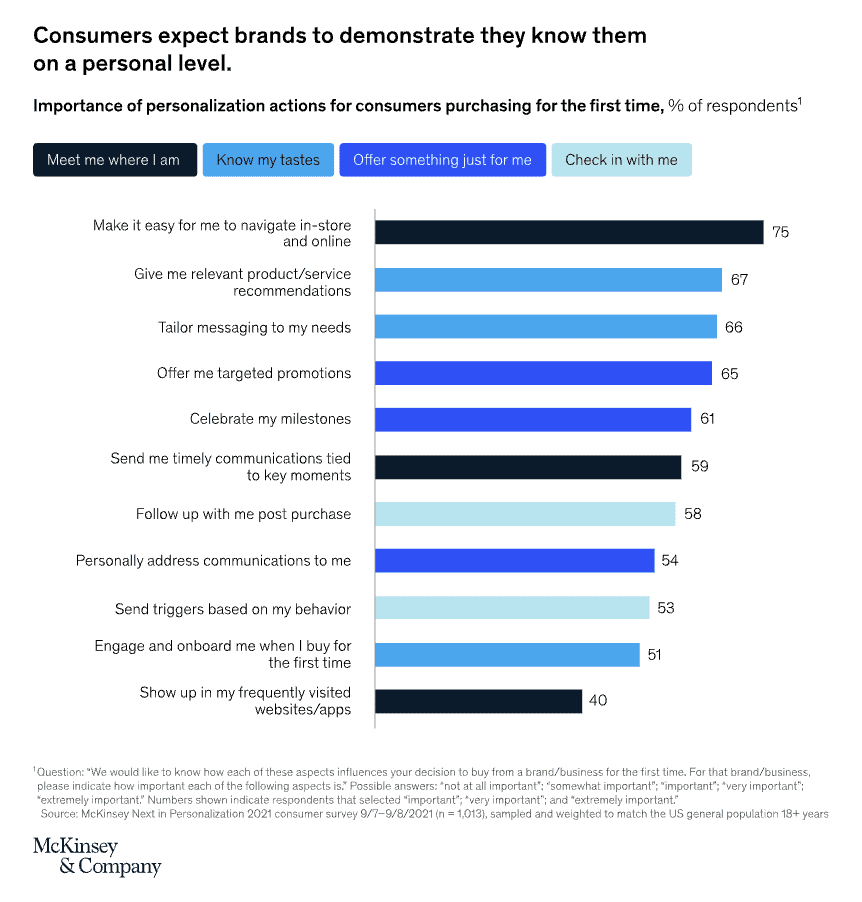
For your next targeted personalization campaign, use dynamic content in emails.
Case study: Netflix
Netflix targets users with tailored content based on what they already engage with. When a new season of a show they watched comes out, or if there is a similar show to stream, Netflix lets them know.
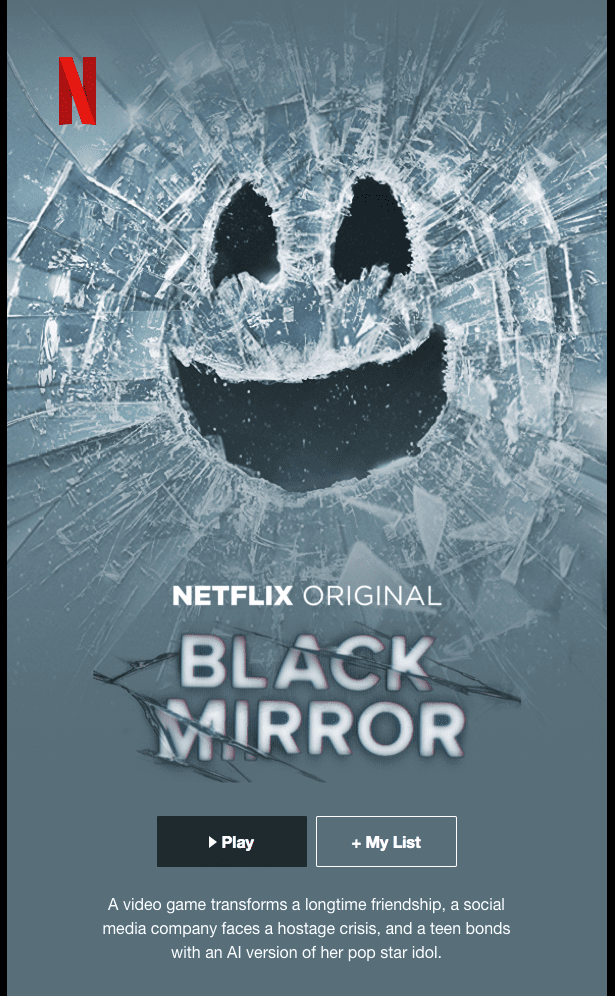
While their emails aren’t the only factor behind Netflix’s 2.4% churn rate, they play a part in their overall marketing strategy.
Further reading: Personalized Emails: How to Reach Customers and Generate Sales
5. A/B test your email marketing content
Hesitating between two subject lines? Not sure what content your audience will react best to? A/B testing is one way to find out — and a great way to optimize your campaigns’ open rates and click-through rates.
Test different email subject line formulas, content formats, and CTAs. See which ones get the best engagement and adjust your strategy accordingly.
6. Optimize email deliverability
Even more than subject lines, calls to action, and copy, email marketing success hinges on reliable email deliverability.
All-important for email marketers, email deliverability refers to the ability to deliver an email to the inbox.
When all goes according to plan, the email makes it past the spam filters and arrives at its destination. When deliverability is compromised, the email lands in the spam folder or, worse, your sender IP is blocklisted by the ISP.
While deliverability often depends on technical factors, there are plenty of non-technical ways to help your email newsletters reach the inbox.
Here are some deliverability best practices:
- Make sure the email subject line doesn’t come across as spammy or overly promotional. If a contact decides your email is spam before even opening it, your deliverability rate is likely to suffer.
- Keep your subscriber database up to date by removing unengaged contacts and inactive addresses.
- Only send to opt-in subscribers. Send emails to someone who’s never heard of you and it’s likely they’ll report you as spam. This will harm your future deliverability.
- Always include an unsubscribe link. Under the GDPR (Europe’s data protection regulation), an individual has the right to dictate how their data is being used. The act of unsubscribing falls fully within those rights so this option should always be available.
Further reading: 8 of the Easiest Ways to Improve Email Deliverability [+ Free eBook]
7. Clean your email list regularly
Keep your database up to date for optimal email deliverability and higher engagement rates.
Got subscribers who’ve dropped off the radar? If someone hasn’t engaged with your emails in at least six months, send a reactivation campaign or even ask for a second opt-in. See if you can get them interested again.
If there’s still no engagement, delete the subscribers from your list.
Sure, no one likes losing subscribers, but email list cleaning is better for your deliverability in the long term
8. Make unsubscribing easy
Make it easy to unsubscribe with a clearly visible unsubscribe button. If people can’t find the way out, they’re more likely to mark you as spam.
Good to know: If you’re using Brevo’s marketing emailing service, you’re already doing this by default and there’s no need to worry.
For reference, a good unsubscribe rate is 0.5 or less.
9. Measure your success with email marketing metrics
Analyzing key email marketing metrics will teach you how to improve your strategy for future campaigns. Most ESPs have an analytics dashboard with at least the following real-time metrics:
- Open rate: The ratio of the number of people who opened your email divided by the total number of recipients.
- Click-through rate: The ratio of the number of people who clicked on a link in your email divided by the total number of recipients.
- Unsubscribe rate: The number of people who unsubscribed divided by the total number of recipients. If this number is high, you need to review your email frequency and segmentation.
- Bounce rate: The number of emails that failed to deliver divided by the total number of emails sent.
- Soft bounces are due to temporary issues like the recipient’s inbox being full.
- Hard bounces, on the other hand, are due to permanent issues, like an inactive email address.
In Brevo, you can find an overview of your campaign results in real time, or under statistics.
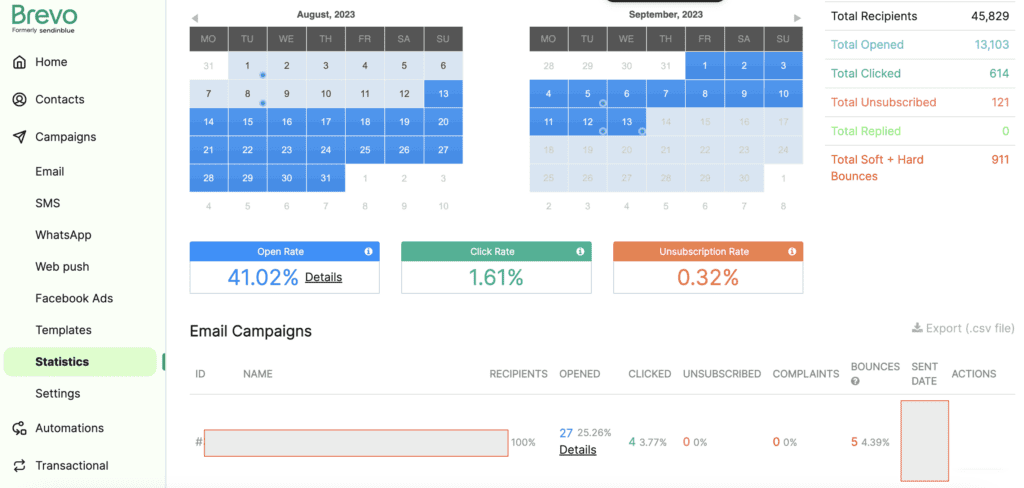
Email campaign statistics in Brevo
To improve your performance, try to manage your email list better to get better engagement.
As you go, you’ll begin to see what works and what doesn’t so you can develop stronger campaigns.
10. Know your local laws and regulations for email marketing
Different regions have different policies for data protection. Make sure to check out guidelines and laws for your area. ESPs help you comply with many important ones, but it’s always good to be safe. As mentioned above, some regulations to know about are:
USA: The CAN-SPAM Act
Europe: The GDPR
Further reading: GDPR in Email Marketing: How to Be Compliant and Avoid Fines
11. Scale with email automation
Once you’ve got the hang of things, automate your email marketing strategy to make your business grow even faster.
Autoresponders are the simplest form of email automation.
Autoresponders send an automatic personalized email (or email series) at different stages of the buyer journey. You get to follow up with subscribers without having to be physically present to hit send.
The welcome email is the most common autoresponder example and most email marketing services have an autoresponder function.
With Brevo, you can select from essential email automations to jumpstart your campaigns.
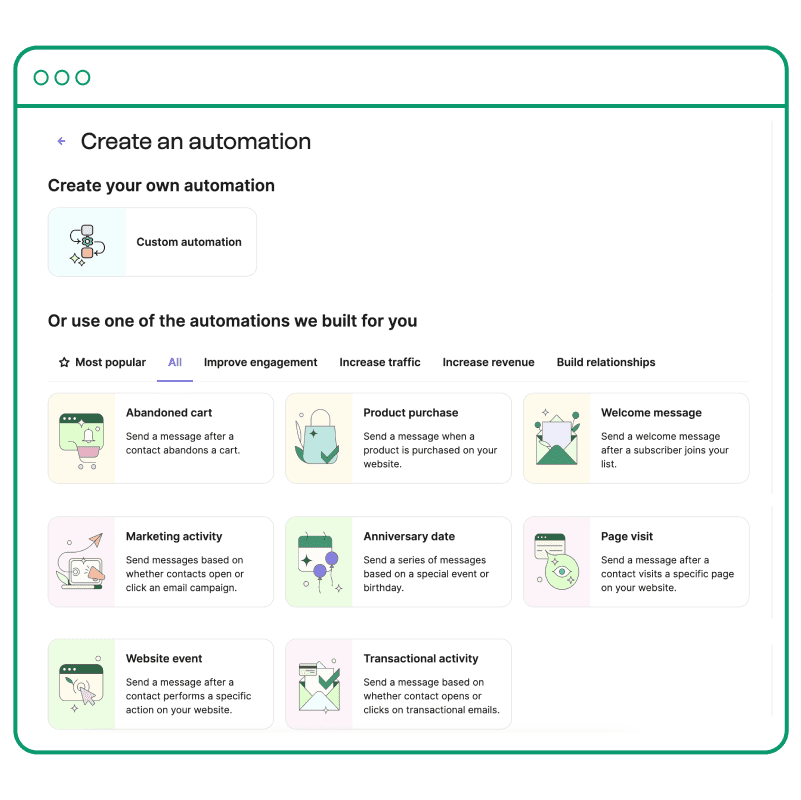
Automation templates in Brevo
You can also build custom workflows inside an automation builder as shown below. Easily click to add entry points, actions, re-starts, and exits.
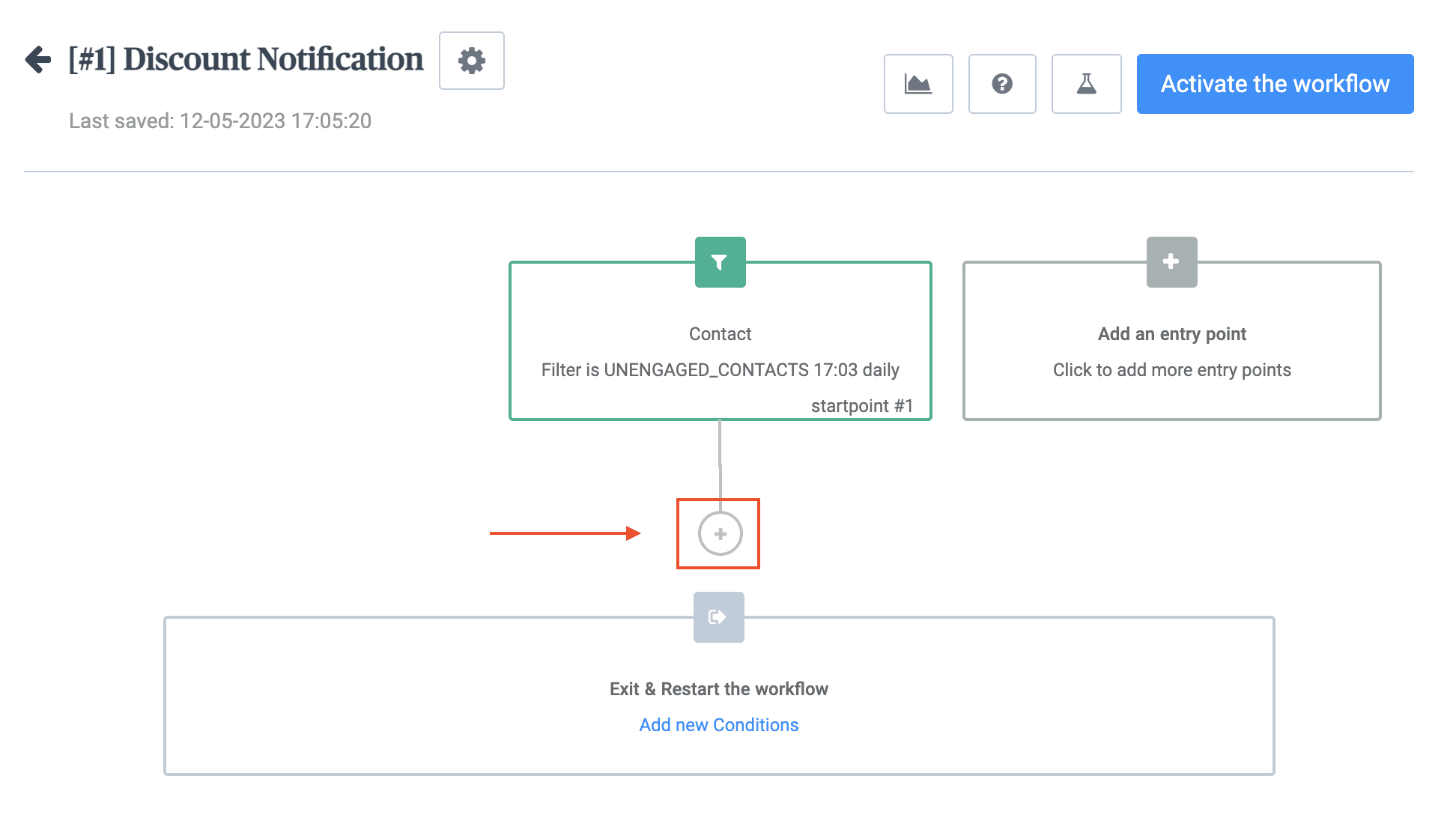
Email automation workflow builder in Brevo
Equipped with the right email automation software, you can go one step further and set up complex email automation sequences using if/then/else logic. This kind of email series is highly effective for lead nurturing and lead scoring.
In the coming year, 48% of companies will focus their efforts on developing their marketing automation. So, learning the basics will help you send successful email marketing campaigns and keep a competitive edge.
Further reading: Marketing Automation Services: 11 of the Best Tools for 2023
Get started with email marketing
Hopefully, this article has given you an in-depth answer to “What is email marketing?” and how it can benefit your business. We know there’s a lot of information here. But by taking things one step at a time, anyone can use email marketing to grow their business.
Get started today with Brevo’s Free Plan to streamline your email marketing efforts. Whatever your industry, Brevo has features and functionalities to create stunning and successful email campaigns that your contacts will love.
Try email marketing with Brevo for freeBrevo’s Free Plan includes access to all core email features, unlimited contact storage, 300 emails/day, 40+ email templates, and customizable signup forms to grow your email list. |









0 Comments